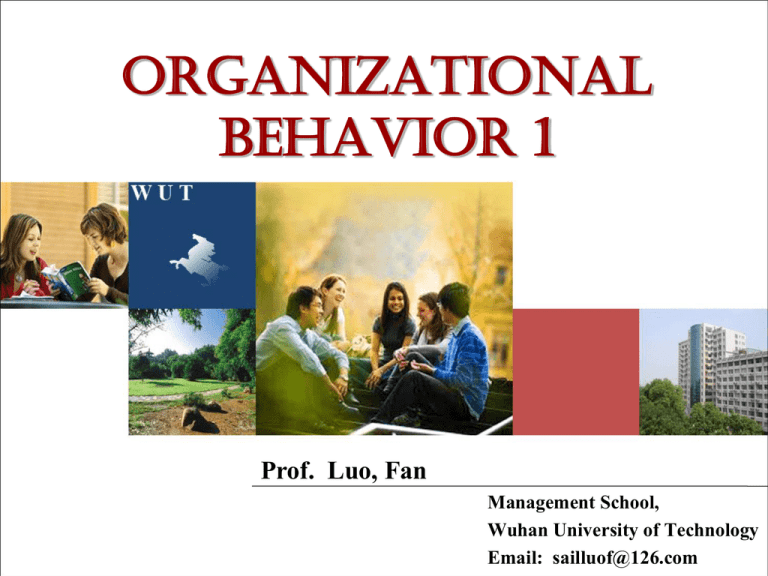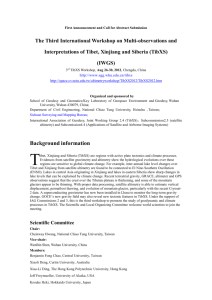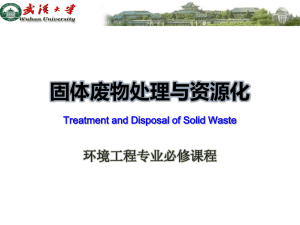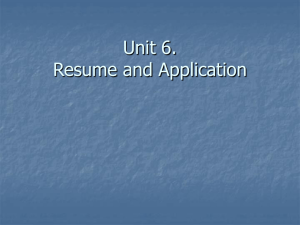Organizational Behavior
advertisement

Organizational Behavior 1 Prof. Luo, Fan Management School, Wuhan University of Technology Email: sailluof@126.com Introduction of the Teacher 1 Education 2 Positions 3 Research fields 4 Honors and Prizes 5 Projects Management School, Wuhan University of Technology Introduction of the Teacher Education Ph.D., Wuhan University of Technology Master, Wuhan University of Technology Bachelor, Beijing University of Aeronautics and Astronautics Management School, Wuhan University of Technology Introduction of the Teacher Positions Professor Associate Chair, Department of Human Resource Management Director, Research Center of Early Warning Management Management School, Wuhan University of Technology Introduction of the Teacher Research fields Human Resource Development and Management Organizational Behavior and Change Management Risk and Crisis Management Management School, Wuhan University of Technology About the textbook Stephen P. Robbins Organizational Behavior (14th Edition) Tsinghua University Press, 2012 Management School, Wuhan University of Technology Teaching Methods 1 Lecture 2. Group Discussion 3. Team Exercise 4 Presentation Management School, Wuhan University of Technology Role Playing Methods of Assessment 20% Attendance & Presentation 30% Team work -Group discussion -case analysis -role playing Management School, Wuhan University of Technology 10% Case Homework (Textbook) 40% Individual Paper-case study in your country 1. What is OB? (1) What Managers Do ? (2) Enter Organizational Behavior (3) Contributing Disciplines to OB (4) Challenges and Opportunities for OB (5) Developing an OB Model Management School, Wuhan University of Technology Teaching Plan Objects Help the students understanding the teaching objects, contents, methods and requirements, so as to enter Organizational Behavior. Teaching Emphases Definitions of Organizational Behavior; Challenges and Opportunities for OB Learning difficulty Managerial Roles; Developing an OB Model Methods Lecture; Case Discussion 1. What is OB? (1) What Managers Do ? Management School, Wuhan University of Technology What Managers Do ? Case: The captain and boat Management School, Wuhan University of Technology What Managers Do ? Questions: How would the boatswain do? Why? What was the captain’s role? What was the boatswain’s role? What were their objects? Were they the successful leaders? How should the captain do? How should the boatswain do? Management School, Wuhan University of Technology Management Functions Organizing Planning Management Functions Leading Management School, Wuhan University of Technology Controlling Management Roles Henry Mintzberg’s Managerial Roles : Interpersonal Roles: Figurehead, Leader, Liaison Informational Roles: Monitor, Disseminator, Spokesperson Decisional Roles: Entrepreneur, Disturbance handler, Resource allocator, Negotiator Management School, Wuhan University of Technology Management Skills Technical skills 技术技能 Human skills 人际技能 Conceptual skills 概念技能 Management School, Wuhan University of Technology Managerial Activities Successful managers Traditional M Effective managers 11% 13% 19% 48% Social Relations Social Relations Social Relations 28% Communication 26% HRM 44% 11% HRM Communication (2) Enter OB OB is a field of study that investigates the impact that individuals, groups, and structure have on behavior within organizations for the purpose of applying such knowledge toward improving an organization’s effectiveness. OB is the study of what people do in an organization and how that behavior affects the performance of the organization. Management School, Wuhan University of Technology Goals of OB Description - Explanation Prediction Control Management School, Wuhan University of Technology www.themegallery.com (3) Contributing Disciplines to OB Psychology Sociology Social Psychology Anthropology Political Science Management School, Wuhan University of Technology Toward an OB Discipline Behavioral Science Psychology Sociology Contribution Learning Motivation Personality Perception Training Leadership effectiveness Job satisfaction Individual decision making Performance appraisal Attitude measurement Employee selection Job design Work stress Psychology Anthropology Science Individual Group Behavioral change Communication Group decision making Cross-cultural analysis Organizational culture Organizational environment Political Output Group dynamics Communication Power Conflict Formal organization theory Bureaucracy Organization technology Organizational change Social Unit of Analysis Conflict Intra-organizational politics Power Organizational System Study of Organizational Behavior (4) Challenges & Opportunities for OB Improving Quality and Productivity Improving People Responding to Globalization Managing Workforce Diversity Empowering People Management School, Wuhan University of Technology Challenges & Opportunities for OB Stimulating Innovation and Change Helping Employees Balance Work/Life Conflicts Declining Employees Loyalty Improving Ethical Behavior Management School, Wuhan University of Technology Globalization Power of Human Resources Cultural Diversity Globalization EmployerEmployee Rapid Change Management School, Wuhan University of Technology New Psychological Contract Diversity Women entering the workforce People of color in the workforce The aging workforce Management School, Wuhan University of Technology Diversity The host of individual difference that make people different from and similar to each other Dimensions Of Diversity ----Primary dimension diversity Age, Gender, Race, Sexual orientation ----Secondary dimension diversity First language, Education, Family status, Geographic location, Income, Religion, Management School, Wuhan University of Technology (5) Developing an OB Model Basic OB Model Organization systems level Text Groups level Text Individual level Text Management School, Wuhan University of Technology Two Basic Questions How? members Organization How? Organization members Management School, Wuhan University of Technology Primary variables The independent variables The dependent variables Individual-level variables Productivity Turnover Group-level variables Absenteeism Organization-level variables Management School, Wuhan University of Technology Job satisfaction The Individual Level in the OB Model Biographical Characteristics Personality Motivation Values and Attitudes Ability Management School, Wuhan University of Technology Productivity Perception Individual decision making Absence Turnover Learning Satisfaction The Group Level in the OB Model Group decision making Leadership Productivity Absence Group Communication Turnover Other Groups Intergroup relations Conflict Management School, Wuhan University of Technology Satisfaction Power and Politics The Organizational System Level Human Resource Policies and Practices Work Stress Productivity Absence Turnover Organizational Culture Management School, Wuhan University of Technology Organization Structure and Design Satisfaction Questions for Critical Thinking Millions of workers have lost their jobs because of downsizing. At the same time, many organizations are complaining that they cannot find qualified people to fill vacancies. Question: How do you explain this apparent contradiction? Management School, Wuhan University of Technology Team Exercise (P32-33) Work Diversity Purpose To learn about the different needs of a diverse workforce. Time Required Approximately 40 minutes. Participants and Roles Divide the class into six groups of approximately equal size. Assign each group one of the following roles. The Roles Nancy is 28 years old. The divorced mother of three children ages 3, 5, and 7, she is the department head. She earns $40,000 per year at her job and receives another $3,600 per year in child support from her exhusband. Ethel is a 72-year-old widow. She works 25 hours per week at an hourly wage of $8.50 to supplement her $8,000 annual pension and earns a total of $19,000 per year. John is a 34-year-old born in Trinidad who is now a U.S. resident. He is married and the father of two small children. John attends college at night and is within a year of earning his bachelor’s degree. His salary is $27,000 per year. His wife is an attorney and earns approximately $50,000 per year. Lu is 26 years old and single with a master’s degree in education. He is paralyzed and confined to a wheelchair as a result of an auto accident. He earns $32,000 per year. Maria is a single, 22-year-old woman born and raised in Mexico. She came to the United States only 3 months ago, and her English needs considerable improvement. She earns $20,000 per year. Mike is a 16-year-old high school sophomore who works 15 hours per week after school and during vacations. He earns $7.20 per hour, or approximately $5,600 per year. The members of each group are to assume the character consistent with their assigned role. Background The six participants work for a company that has recently installed a flexible benefits program. Instead of the traditional “one benefit package fits all,” the company is allocating an additional 25 percent of each employee’s annual pay to be used for discretionary benefits. Those benefits and their annual cost Supplementary health care for employee: Plan A (no deductible and pays 90 percent)=$3,000 Plan B ($200 deductible and pays 80 percent) =$2,000 Plan C ($1,000 deductible and pays 70 percent) = $500 Supplementary health care for dependents (same deductibles and percentages as above): Plan A = $2,000 Plan B = $1,500 Plan C = $500 Supplementary dental plan = $500 Source: Life insurance: Plan A ($25,000 coverage) = $500 Plan B ($50,000 coverage) = $1,000 Plan C ($100,000 coverage) = $2,000 Plan D ($250,000 coverage) = $3,000 Mental health plan = $500 Prepaid legal assistance = $300 Vacation = 2 percent of annual pay for each week, up to 6 weeks a year Pension at retirement equal to approximately 50 percent of final annual earnings = $1,500 4-day workweek during the 3 summer months (available only to full-time employees) = 4 percent of annual pay Day care services (after company contribution) = $2,000 for all of an employee’s children, regardless of number Company-provided transportation to and from work = $750 College tuition reimbursement = $1,000 Language class tuition reimbursement = $500 The Task 1. Each group has 15 minutes to develop a flexible benefits package that consumes 25% of their character’s pay. 2.Each group appoints a spokesperson who describes to the entire class the benefits package. 3. Discusses the results. Questions: How did the needs, concerns, and problems of each participant influence the group’s decision? What do the results suggest for trying to motivate a diverse workforce? Management School, Wuhan University of Technology Wuhan University of Technology Email: sailluof@126.com










